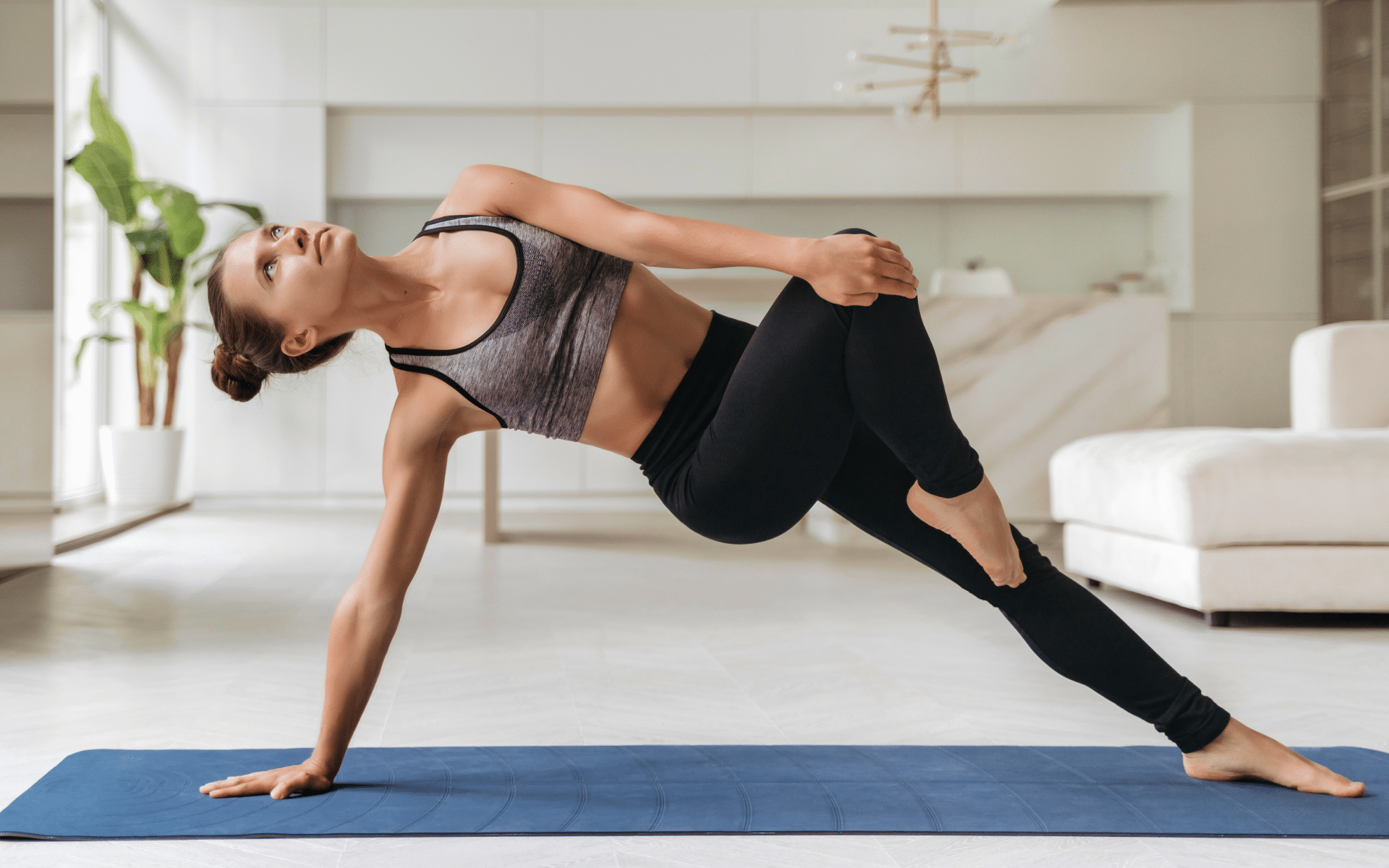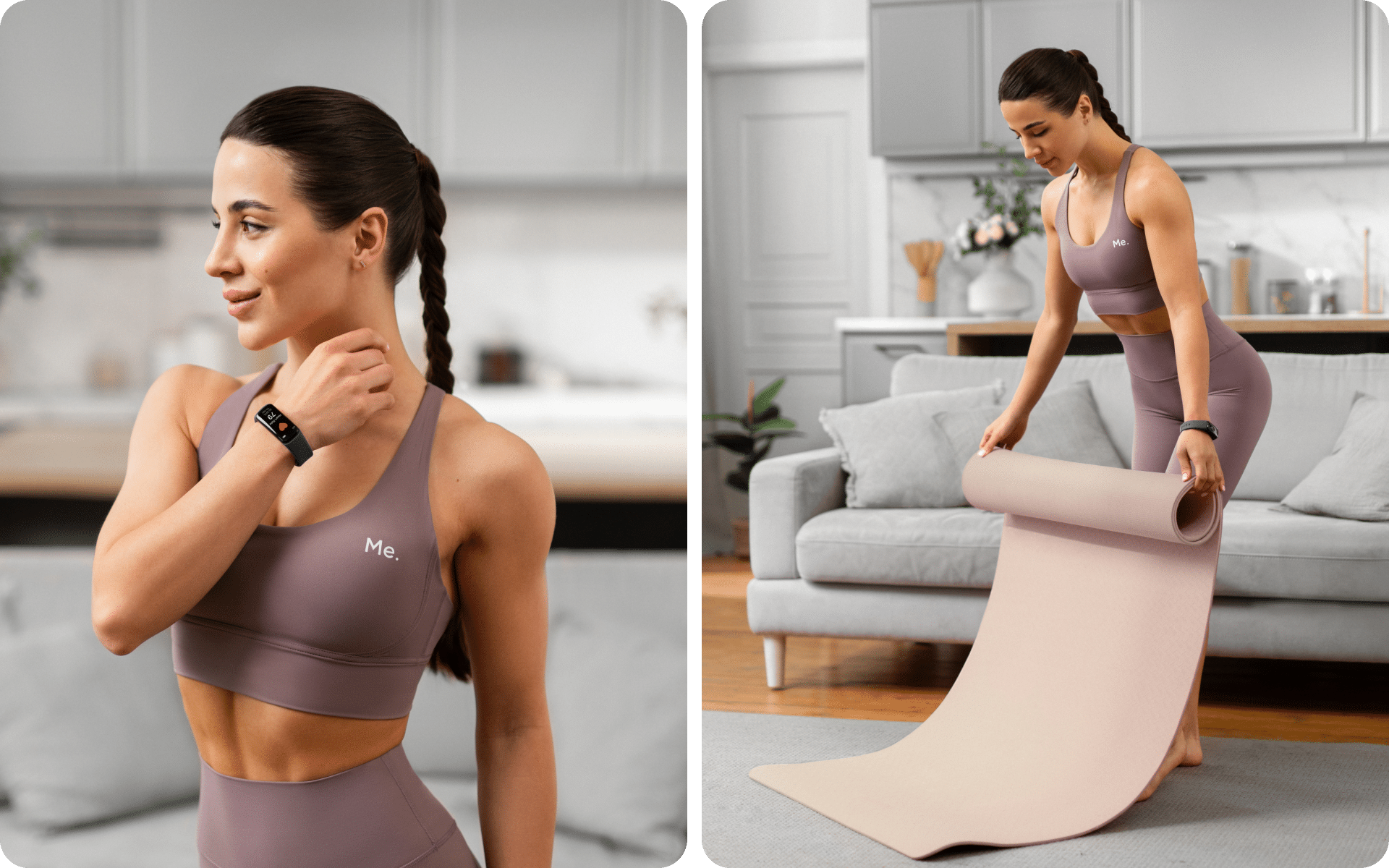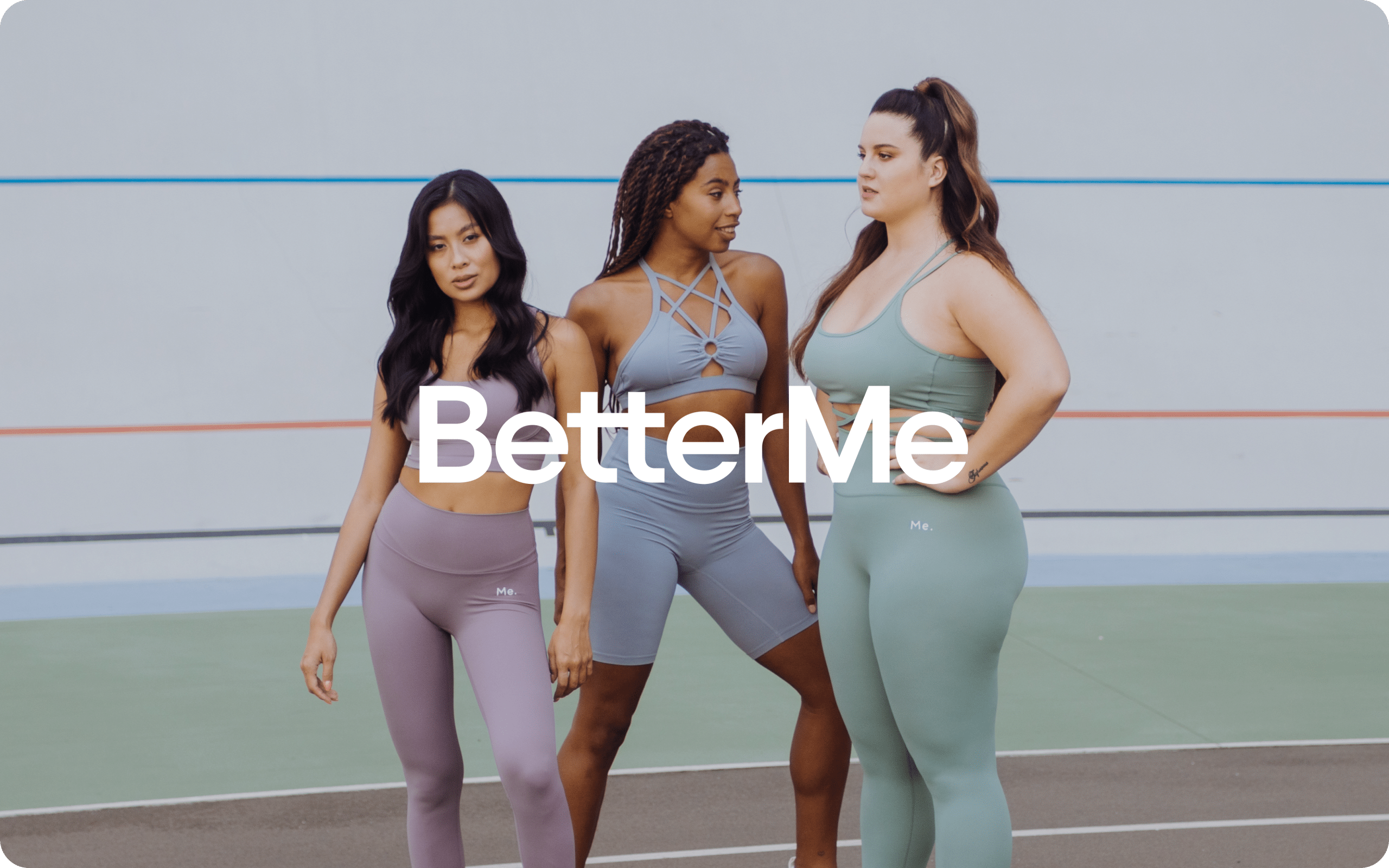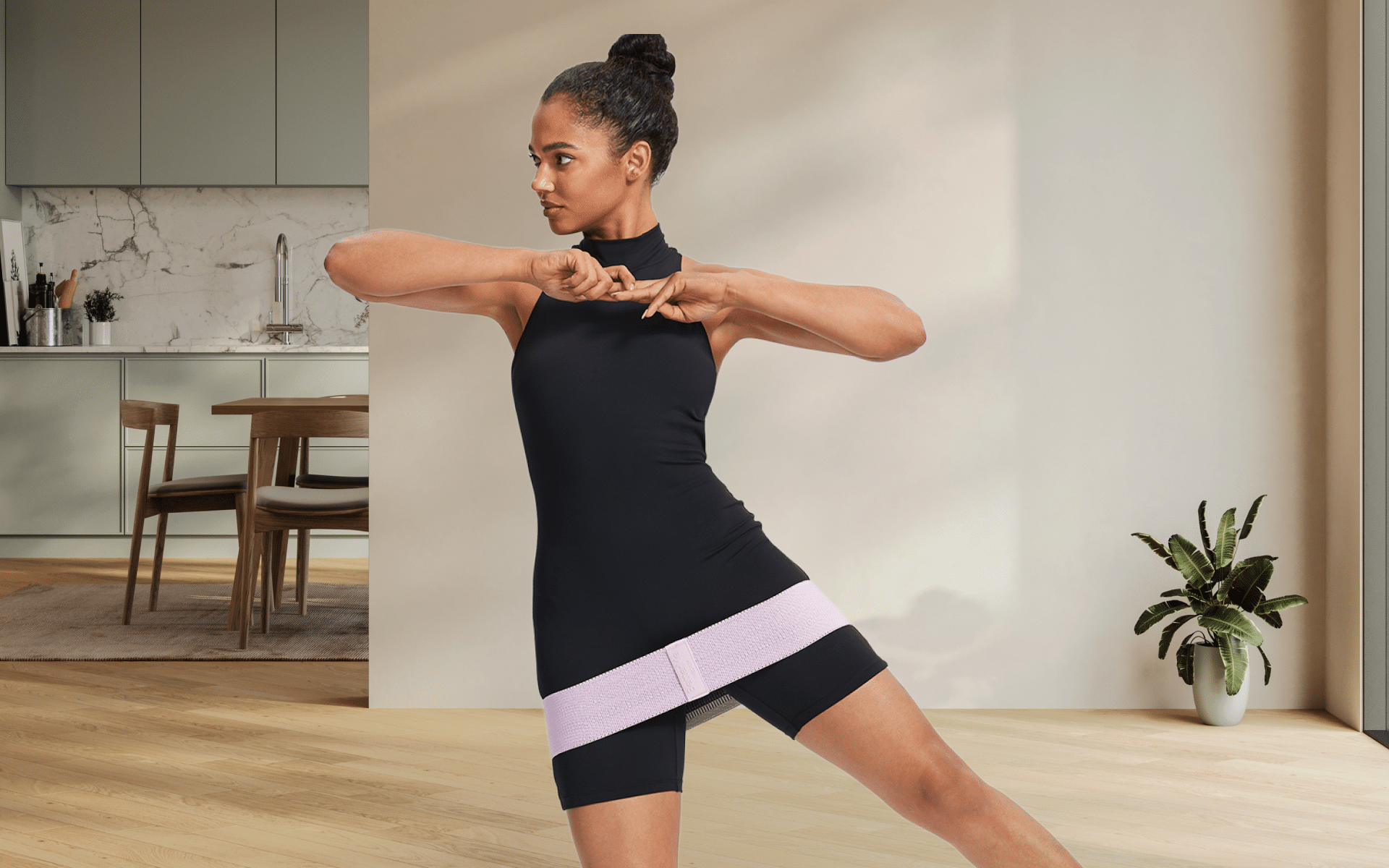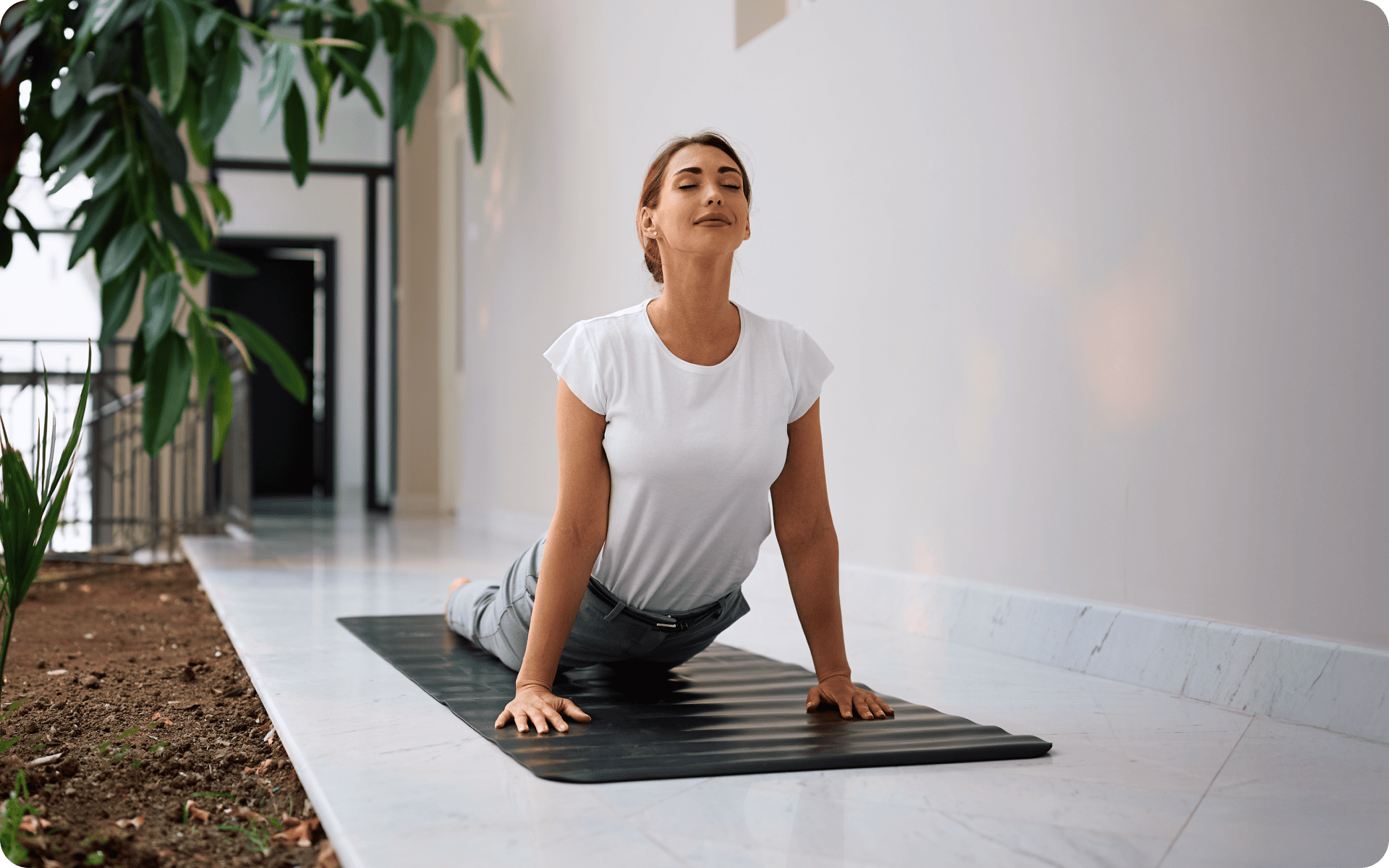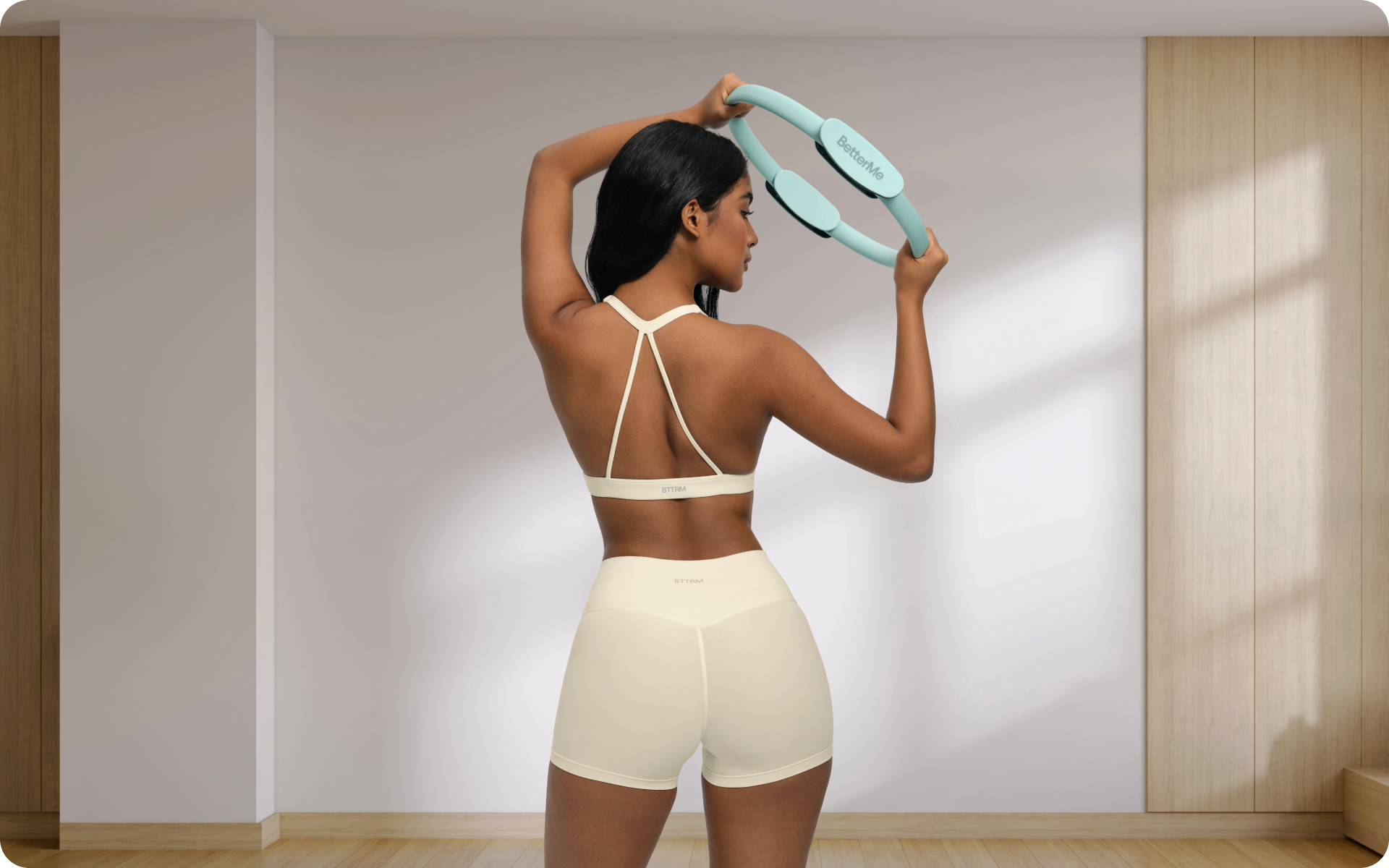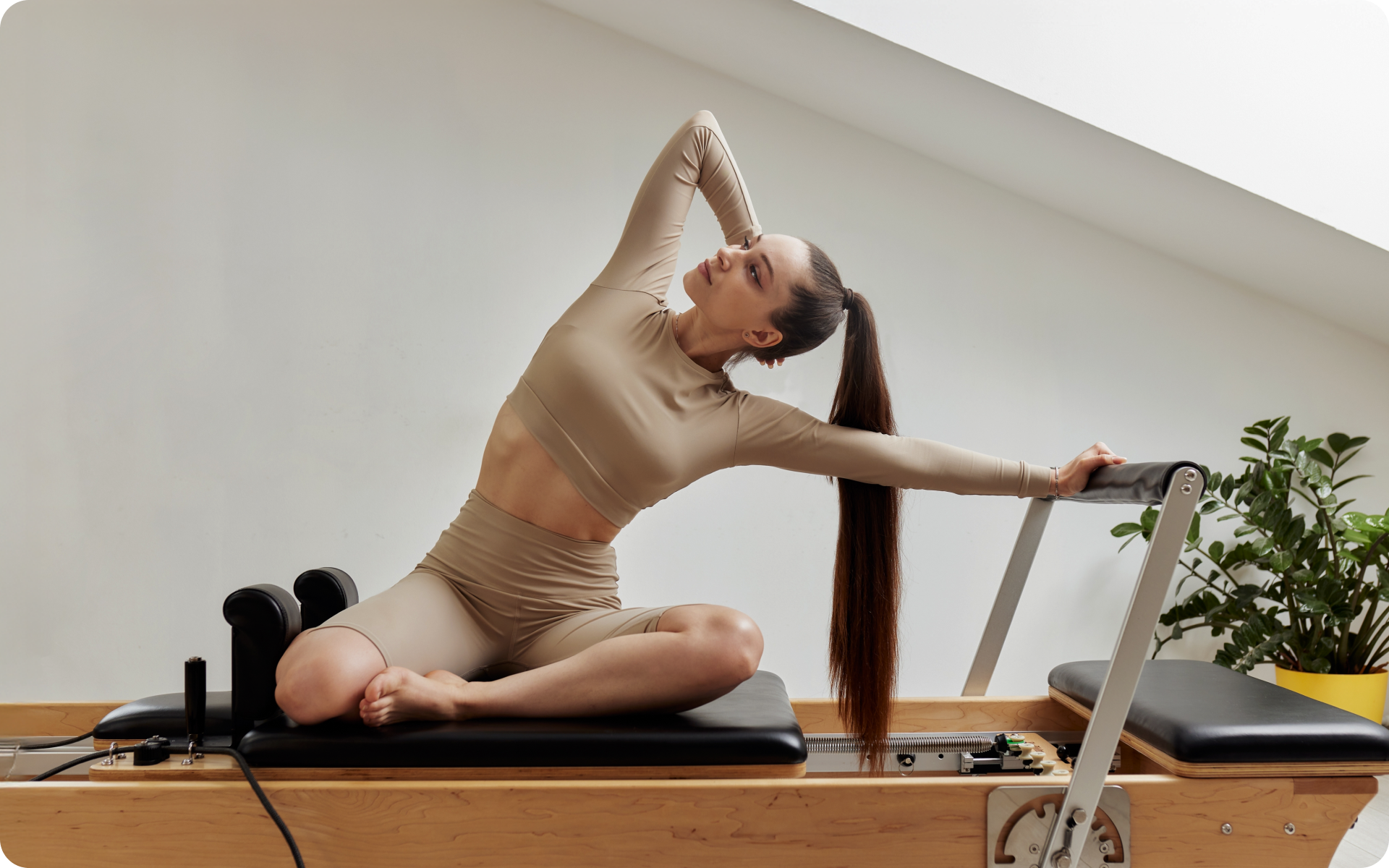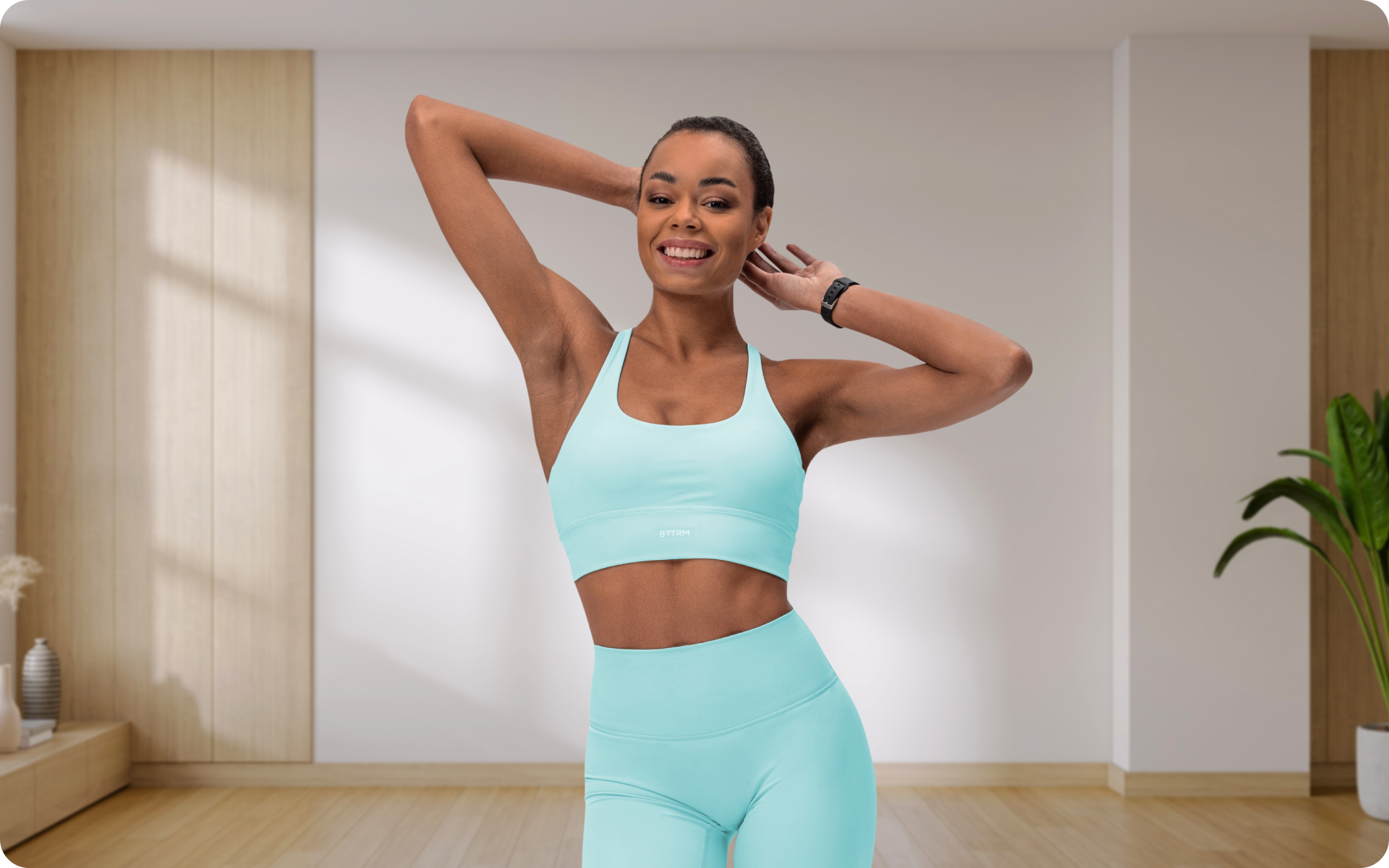Are you considering Pilates as an entry-level muscle builder or looking to tone muscles without much injury risk? Perhaps you’re wondering if Pilates could complement your strength and weight training. The direct question is, does Pilates build muscle? Pilates is an incredible stretching and conditioning workout routine. However, you won’t build bulk muscle mass or pump your abs. Still, Pilates has muscle benefits and may help new exercisers enter the world of workouts. Let’s understand what Pilates does and doesn’t do.
The Truth About Pilates And Muscle-Building
The Pilates Foundation credits Joseph Pilates, but they don’t forget about his wife, Clara Pilates (21). Few people realize that it was Clara who taught apprentices to help gym members condition, tone, and strengthen muscles in the 1920s.
The duo led body conditioning with six principles (21). The principles included breathwork, conscious focus, centering, precision, control, and flow. Gym members learned to marry the mind and body to condition the latter.
Ultimately, the workout became similar to yoga, except it takes a step further to focus your body on stabilizing your core. WebMD explains Pilates requires you to flow into a position before controlling your arm and leg movements to teach core stability (8).
You focus on the motions and breathing. So, it’s slightly different from regular strength training and weightlifting that build muscle mass. Let’s see how they differ by first understanding what’s muscle mass.
Will Pilates Build Muscle Mass?
Bastyr University in Kenmore, Washington, explains the mechanisms of muscular movements during Pilates (17). Pilates is a full-body muscular exertion that doesn’t focus on a single muscle group. Pilates is a whole-body internal resistance exercise.
Pilates can stimulate increased motor unit recruitment, which is the force and resistance of a workout (11). However, only high-intensity Pilates with an intensity-enhancing apparatus can increase the progressive load enough to cause hypertrophy.
Live Science describes hypertrophy as an increase in size and number of muscle fibers within a muscle or group that causes muscle mass (23). This doesn’t explain anything about lengthening of muscles. Muscle lengthening is purely a myth because they can’t grow longer.
The University of New Mexico uses a diaphragm to show how muscles work in various intensity workouts (11). Heavy load or progressive overload muscular workouts are necessary to stimulate both muscle fibers.
Bastry University has shown how Pilates primarily stimulates the slow-twitch fibers to be more resilient to longer workouts (17). New York’s Lehman College described how high-intensity exercises stimulate both muscle fiber types necessary to build mass (17).
Classic Pilates alone can’t build lean mass. This is to say, you aren’t gaining muscle mass unless you use high-intensity Pilates with intensity-enhancing apparatuses. Switching between high-intensity strength training and Pilates can also give you the desired effect.
Read More: Barre Vs Pilates: Which Is Right For You?
Will Pilates Make You Gain Muscle Weight?
The Mayo Clinic states that strength training adds weight because of extra muscle mass (19). Unfortunately, Pilates doesn’t build muscle mass once you tone up. This means it can’t enable you to carry excess weight. In addition, classic Pilates isn’t explosive or intense enough.
Fitness expert Daniel Bubnis explains how muscle growth happens when you challenge the muscles to more intense resistance (4). Hypertrophy also damages the type II muscle fibers, and your body sends satellite cells to repair them.
These cells increase the weight of your muscles, causing them to look more significant (but not longer). Cells fuse to repair muscles, adding weight and growth. Also, Bubnis explains how hormones play a role (4). Muscles grow when these hormones increase:
- Human Growth Hormone,
- Insulin Growth Factor,
- Testosterone.
University confirms that protein is an essential nutrient for building muscle mass and weight (7). The hormones improve how your body processes and inhibits protein. Eastern Michigan The hormones also promote tissue growth around your muscles.
Interestingly, the role of testosterone in muscle growth also explains why women don’t build muscle as quickly as men. Fitness expert Daniel Bubnis confirms gender hormones affect muscle growth (4). However, women have estrogen doing a similar job to testosterone.
Finally, Bubnis dives into how body types affect muscle growth and mass (4). Three different body types can affect how you build muscle with or without high-intensity workouts. The University of Houston describes the three body types (20):
- Ectomorph: This type is lean with little fat or muscle and needs high-intensity workouts to build mass.
- Endomorph: This type is curvacious and needs high-intensity workouts.
- Mesomorph: This type is solid, healthy, and would build mass with most exercises.
BetterMe app will kick you out of the mental funk, shake off your extra weight, rid you off your energy-zapping habits, and help you sculpt the body of your dreams. Intrigued? Hurry up and change your life for the better!
Why Would You Use Pilates If Not For Muscle Growth?
Pilates is an internal resistance exercise that improves your coordination and balance. Furthermore, it has excellent health, toning, and mental health benefits. The American College of Sports Medicine recommends Pilates for various uses (2).
Pilates Improves Mental Health And Reduces Pain Perception
German Sport University Cologne reviewed how Pilates can help healthy and unhealthy adults (9). Pilates helps people with or without clinical conditions. Quality of life, depression levels, sleep, and chronic pain occurrence improved significantly among the older crowd.
Pilates To Build Muscle Tone
The Cleveland Clinic recommends Pilates to tone muscles more than build mass (14). You might not build excessive muscle mass, especially with classic Pilates. However, it will help you tone muscles to get your desired shape. You’ll have a leaner look with Pilates.
Pilates Helps Weight Loss
The Houston Methodist Medical Center confirms weight loss is a Pilates benefit (1). Pilates doesn’t burn calories like traditional aerobic exercises. Instead, it improves your basal metabolic rate to burn fat while you rest. Pilates enhances your chance of weight loss.
Pilates Improves Core Stability (Endurance, Strength, Flexibility, And Lower Injury Risk)
Why is core stabilization, strengthening, endurance, and flexibility necessary? The Goodwin Living Foundation explains why core stabilization matters (3). The core muscles aren’t specific to your abdomen. Instead, they consist of two major muscle types.
The types are the inner and outer core (3). The inner core muscles provide stability and control when you move. They lie deep in your body and close to your spine, including:
- Diaphragm muscles control breathing and abdominal pressure,
- Internal obliques help move the body sideways and breathe,
- Multifidus muscles run along the spine to offer stable support,
- Pelvic floor muscles control bladder and bowel movements and sex organs,
- Transversus abdominis muscles are the deepest ab muscles that support limb movements, pelvic floor muscles, and the lower back.
Then, you have the outer core muscles that control the more extensive movements and your body’s trunk (3). These muscles and their responsibilities include:
- External obliques are on the outside and front of your abdomen, and they help you move side-to-side and support inner core muscles,
- Erector spinae muscles line the sides of your spine and aid in all upper body motions,
- Rectus abdominis muscles are what we think are abs and help you bend over.
The Goodwin Living Foundation says other muscles, like the glutes, comprise the core structure (3). However, you have the main inner and outer core muscles, also known as global and local muscles.
This anatomy lesson matters because we see how the inner core muscles work with the outer core muscles. Not many exercises target the deeper internal core muscle systems. However, the Patil College of Physiotherapy has proved Pilates works the inner core muscles (3).
Furthermore, the Mayo Clinic recommends stabilizing core muscles to be more flexible, endure longer workouts, and perform better overall (5). You’ll have better balance and fine-tune your abs. Meanwhile, you’ll prevent injuries by making your muscles more flexible.
Read More: Do These Pilates Exercises At Home To Tone Your Core
Pilates Muscles Worked
Bastyr University discovered the muscles Pilates targets when muscle exertion happens (17). Here’s how the muscles in your inner and outer core work with Pilates:
- Abdominal Core Muscles: Pilates has a minimal impact on your spine while working on the rectus abdominis, transverses abdominis, and the internal and external obliques,
- Body Position Core Muscles: Pilates activates the cervical vertebrae, pelvic floor muscles, multifidus, and erector spinae muscles to improve position,
- Motor Control Core Muscles: Pilates improves flexibility and endurance in the glutes, diaphragm, multifidus, transversus abdominis, and internal and external obliques. You’ll have better motor control with Pilates muscles worked.
Dr. Tyler Wheeler says you’ll experience muscle benefits in your arms and legs with Pilates (16). She also explains how improving the core muscle structure with Pilates will help limb movements. You’ll have more control over the muscles in your arms and legs.
The Houston Methodist Medical Center further states that Pilates will improve inner thigh muscles, glutes, and hip muscles (1). Everything’s connected to your core, so you’re doing a whole-body muscle workout when you enjoy Pilates.
The psoas core muscles are hip flexors controlling everything in the lower limbs. They connect the hip and spine, creating stability at a significant point. Pendelton Pilates explains how Pilates improves the psoas muscles (15).
Shoulder movements rely on teres major and minor muscles. Pilates can make these muscles more flexible to help your core movements and control. Finally, Pilates expert Melanie Bermudez explains how Pilates improves the girdle in your shoulders (18).
How To Build Muscle With Pilates In 3 Ways
Building lean muscle mass requires three methods. These three methods are complementary muscle-builders. You can cross-train, add apparatuses, or use Pilates as a beginner trainer. However, remember the facts. Let’s see how each technique works.
Using Classic Pilates To Build Muscle As A New Exerciser
Pilates will tone your muscles and give you a lean mass effect as a beginner. Dr. Tyler Wheeler confirms beginners can tone their muscles with Pilates (16). It works if you’re out of shape. Also, you can cross-train or add intensity once you hit the muscle wall.
Using Pilates Apparatuses To Build Muscle And Increase Intensity
Pilates with apparatuses can increase the intensity of your whole-body workout. For example, the Trifocus Fitness Academy suggests using an adjustable Pilates reformer to increase resistance training (22). You won’t bulk up overnight, but it adds intensity.
Physiotherapist Louise O’Rourke suggests the following equipment to enhance Pilates intensity (10):
- Flex Bands increase resistance and power during Pilates workouts,
- Mini Flex Balls improve intensity for the thigh muscles,
- Stability Balls increase intensity during stability Pilates workouts,
- Toning Balls add small weights to your Pilates exercise,
- Pilates Reformers or Towers are adjustable machines that improve resistance.
Lean and toned up body isn’t just a far-fetched fantasy. Check out the BetterMe app and watch it propel your weight loss journey into high gear!
Integrating Exercises To Build Muscle And Cross-Train
The Mayo Clinic confirms strength training builds muscle, bulks, and improves muscle weight (19). So, why not combine strength training and Pilates to build muscle while staying toned and stable? Strong Fitness Magazine also recommends cross-training (24):
- Attend two to three Pilates classes weekly, back-to-back.
- Use strength training, weightlifting, or high-intensity workouts on other days.
- Alternatively, finish strength training with mild Pilates workouts.
FAQs
Does Pilates Help You Build Muscle?
Bastyr University examined high-intensity versus low-intensity Pilates (17). Classic Pilates alone can’t help you build muscle mass. Meanwhile, high-intensity variations can aid muscle gain. However, high-intensity Pilates works better for some body types (4).
Does Pilates Build Muscle Mass?
Bastry University describes Pilates as a low-intensity, whole-body resistance workout (17). Still, the University of New Mexico’s diaphragm shows you need high-intensity exercises to stimulate the right muscle fibers (11). That said, you can’t quickly build mass with classic Pilates.
Is Pilates Good For Muscle-Building?
Live Science says hypertrophy is the best way to stimulate muscle-building (23). Unfortunately, Bastry University states that classic Pilates doesn’t cause hypertrophy (17). Combine Pilates with vigorous exercises or use apparatuses to increase the intensity.
What Does Pilates Do To Your Muscles?
Pilates has muscle benefits. The American College of Sports Medicine has shown how Pilates improves muscle strength, endurance, and flexibility (2). Pilates also improves balance, coordination, and posture while reducing the risk of muscle injuries.
The Bottom Line
Pilates won’t buff you or make your abs talk. However, they’re an excellent workout to add to your lifestyle routine, even to support strength training. A more stable core with higher performance will help you build muscle with other exercises. On that note, start Pilates today!
DISCLAIMER:
This article is intended for general informational purposes only and does not serve to address individual circumstances. It is not a substitute for professional advice or help and should not be relied on for making any kind of decision-making. Any action taken as a direct or indirect result of the information in this article is entirely at your own risk and is your sole responsibility.
BetterMe, its content staff, and its medical advisors accept no responsibility for inaccuracies, errors, misstatements, inconsistencies, or omissions and specifically disclaim any liability, loss or risk, personal, professional or otherwise, which may be incurred as a consequence, directly or indirectly, of the use and/or application of any content.
You should always seek the advice of your physician or other qualified health provider with any questions you may have regarding a medical condition or your specific situation. Never disregard professional medical advice or delay seeking it because of BetterMe content. If you suspect or think you may have a medical emergency, call your doctor.
SOURCES:
- 5 Benefits of Pilates That Might Convince You to Add it to Your Workout Regimen (2022, houstonmethodist.org)
- American College of Sports Medicine Position Stand: Quality and Quantity of Exercise for Developing and Maintaining Cardiorespiratory, Musculoskeletal, and Neuromotor Fitness in Apparently Health Adults: Guidance for Prescribing Exercise (2011, nih.gov)
- Anatomy Lesson: The Core, Our Center for Stability and Motion (2021, goodwinliving.org)
- Building Muscle With Exercise: How Muscle Builds, Routines, Etc (2020, medicalnewstoday.com)
- Core Exercises: Why You Should Strengthen Your Core Muscles (2022, mayoclinic.org)
- Core Stabilization Exercise Prescription: Part 1 (2013, nih.gov)
- Dietary Protein and Muscle Mass: Translating Science to Application and Health Benefit (2019, nih.gov)
- Difference Between Pilates and Yoga (2021, webmd.com)
- Effects of Pilates Training on Physiological Health Parameters Healthy Older Adults and in Older Adults With Clinical Conditions Over 55 Years: A Meta-Analytical Overview (2021, nih.gov)
- Is Equipment Used in Pilates? (2016, louiseorourkephysiotherapy.ie)
- Motor Unit: All-or-None Response of Motor Units and Motor Unit Recruitment (n.d., unm.edu)
- Muscle Fiber Type Transitions With Exercise Training: Shifting Perspectives (2021, nih.gov)
- (PDF) Effects of Pilates on Core Muscle Strength and Endurance in Post-Six Month’s Delivery Women (2020, researchgate.net)
- Pilates 101: What It Is and Health Benefits (2023, clevelandclinic.org)
- Pilates and the Psoas Muscle (n.d., pendeltonpilates.com)
- Pilates: What It Is, Benefits, and More (2021, webmd.com)
- Pilates: How Does It Work, and Who Needs It? (2011, nih.gov)
- Shoulder Girdle Stabilization (2018, melaniebermudezpilates.com)
- Strength Training: Get Stronger, Leaner, Healthier (2021, mayoclinic.org)
- The 3 Somatotypes (n.d., uh.edu)
- The History of Pilates (n.d., pilatesfoundation.org)
- What Are the Benefits of Using a Pilates Reformer? (2022, trifocusfitnessacademy.co.za)
- What Is Hypertrophy? (2022, livescience.com)
- Why Pilates-Style Workouts Are the Perfect Complement to Weight Training (2019, strongfitnessmag.com)
